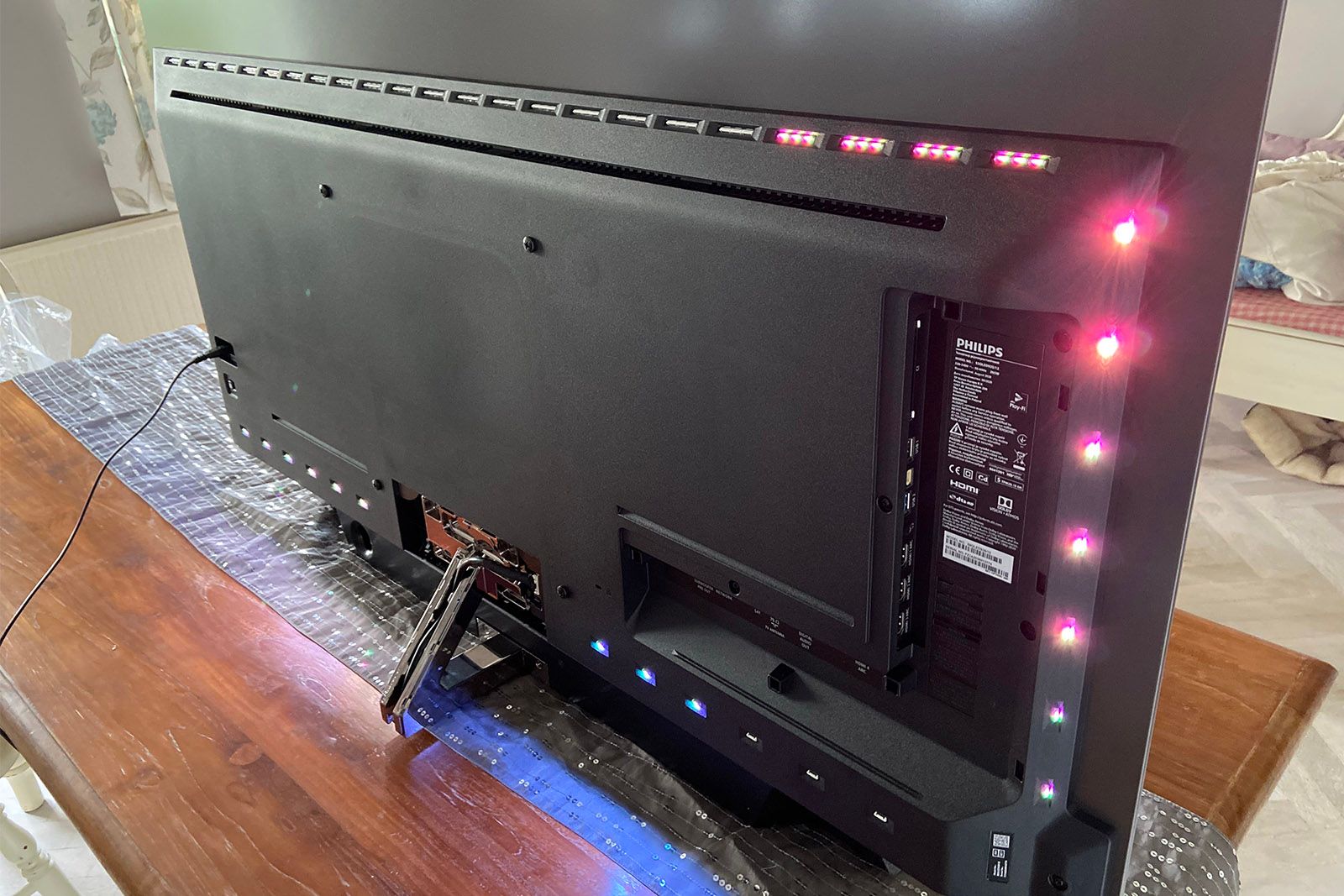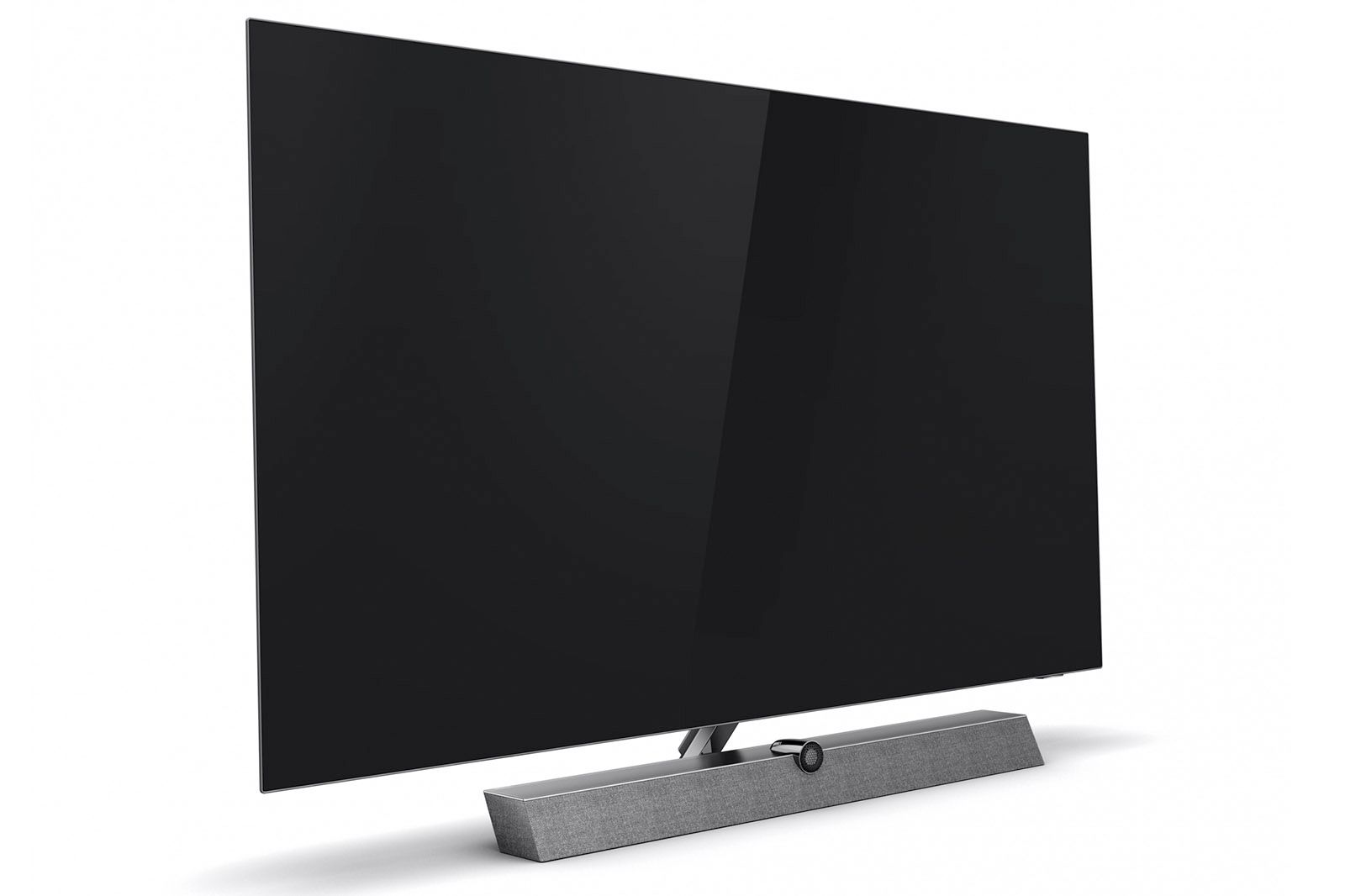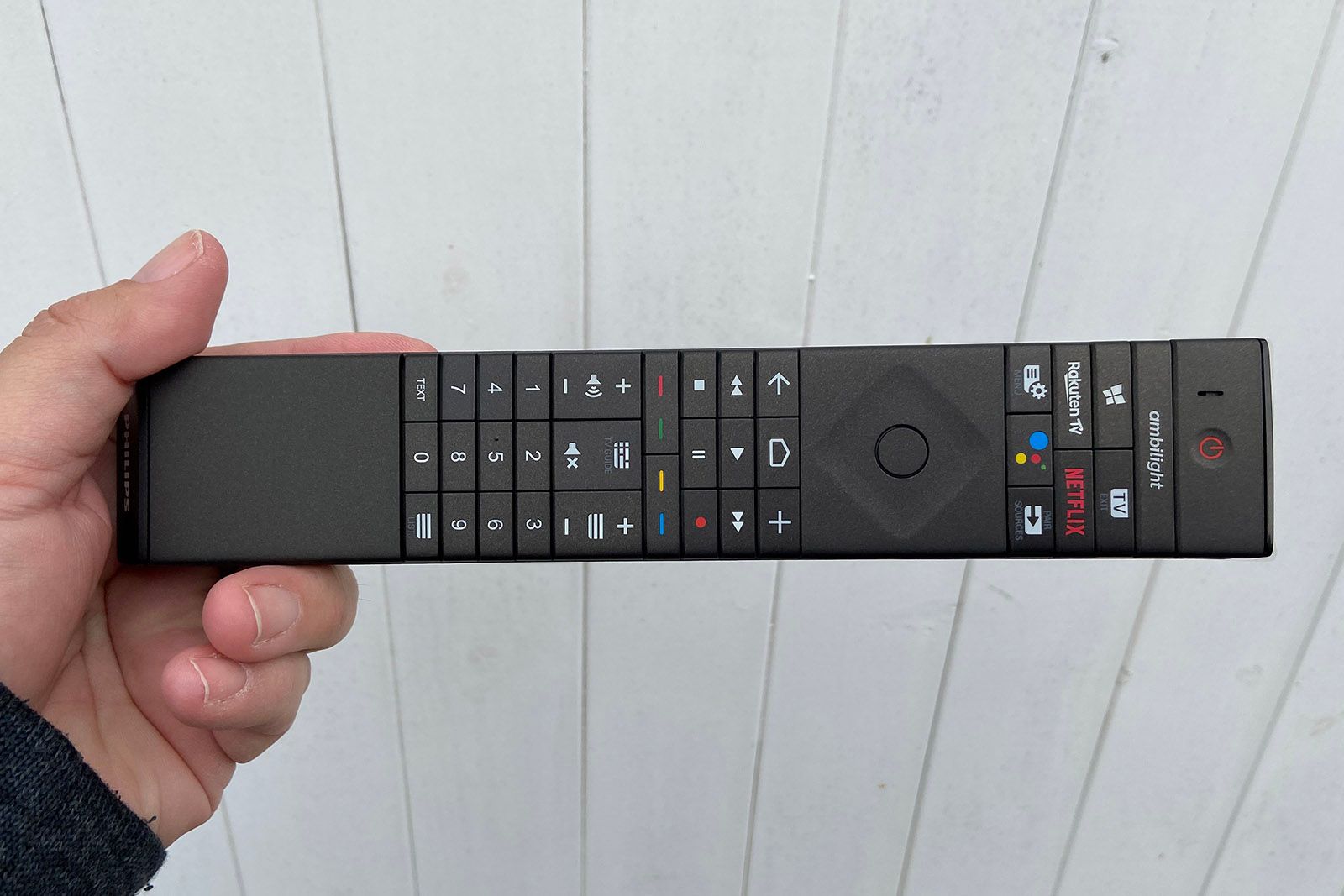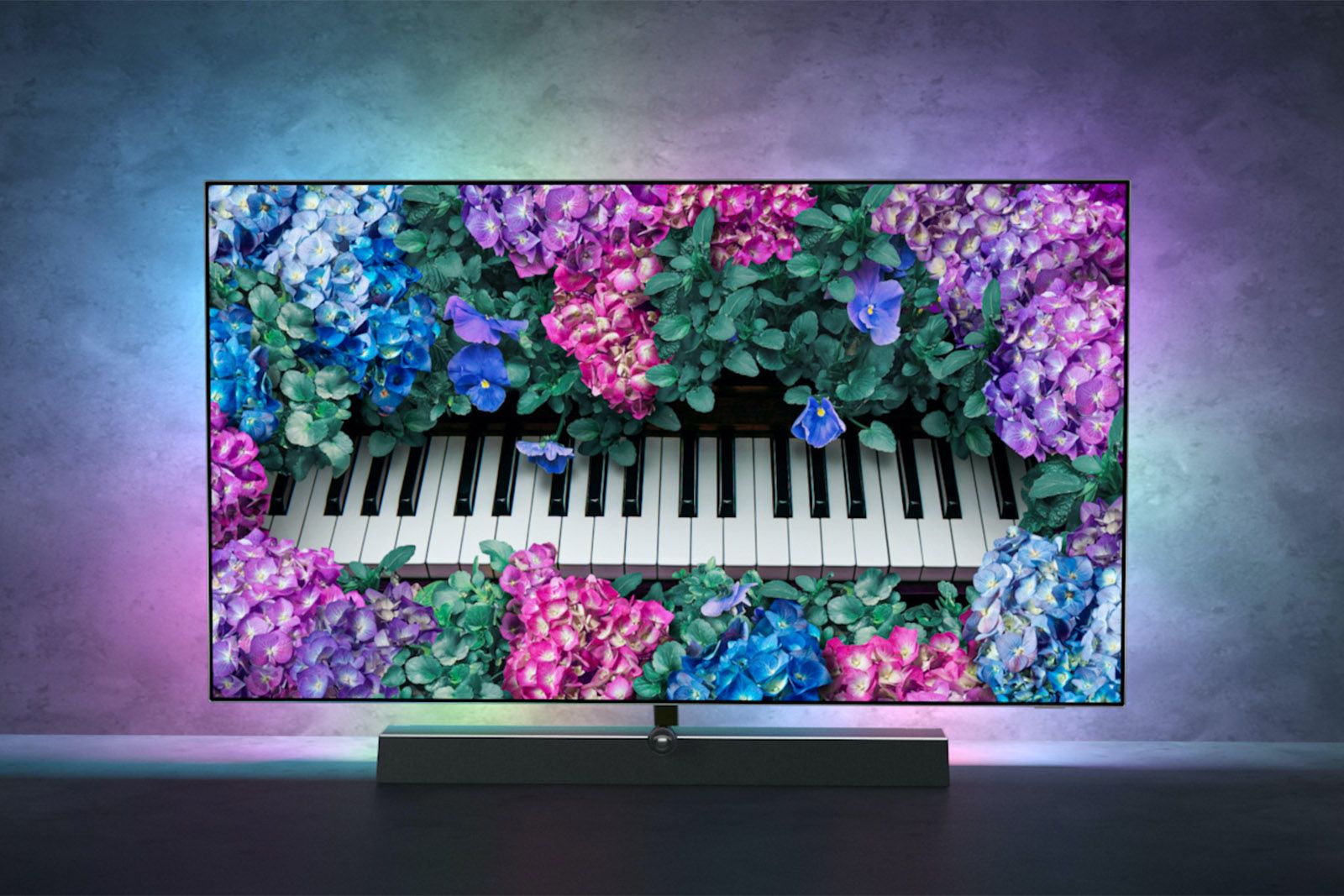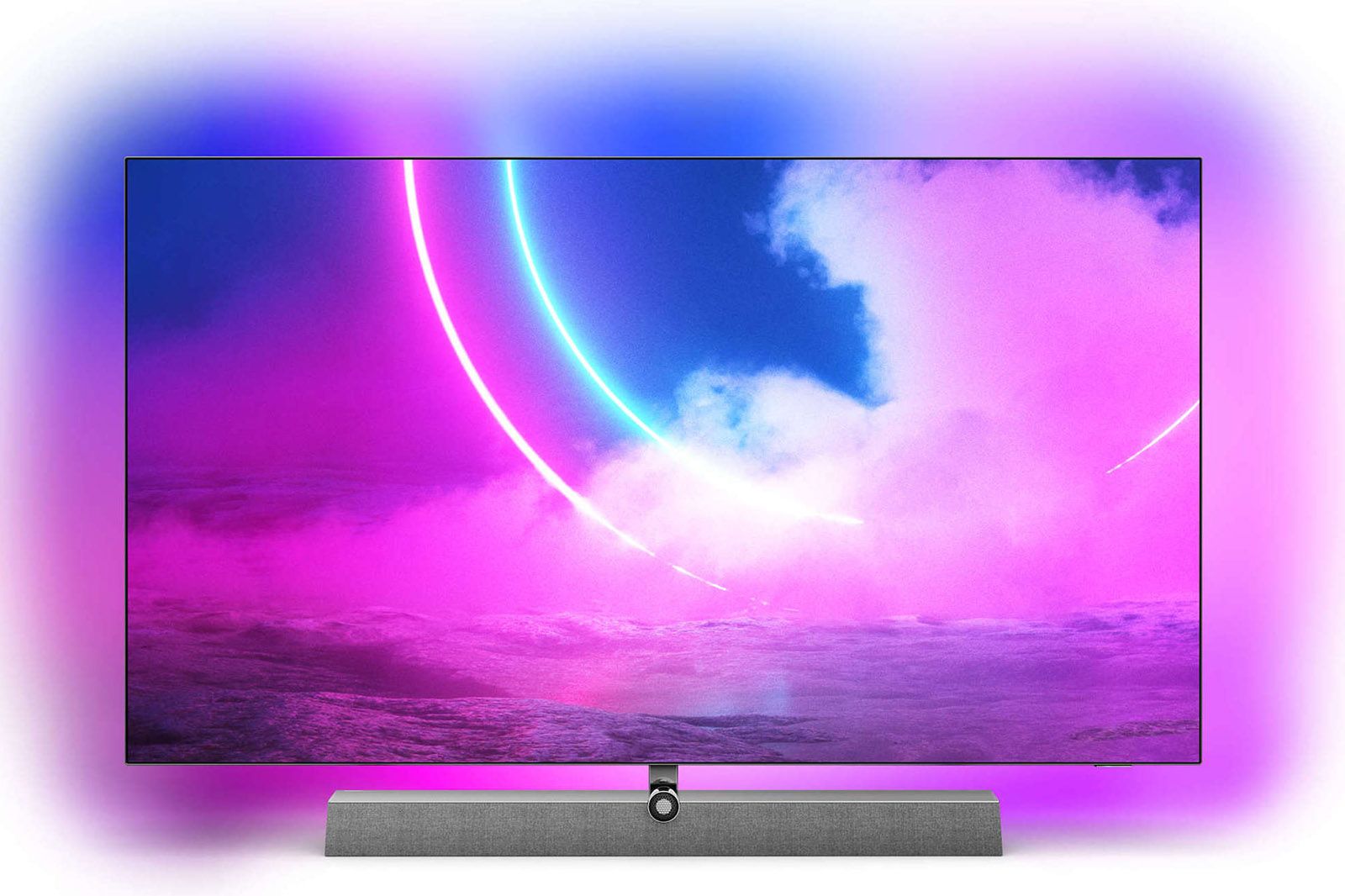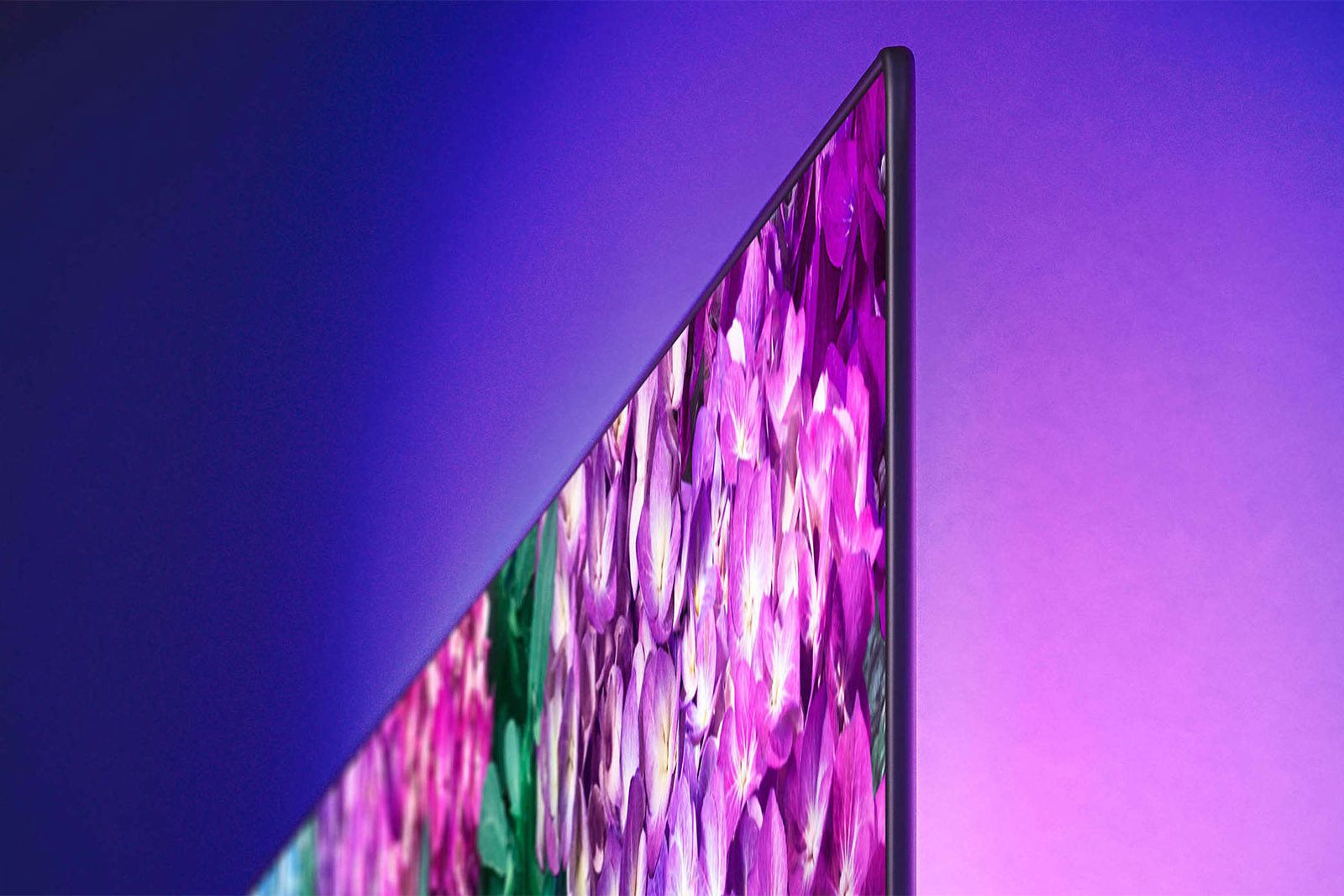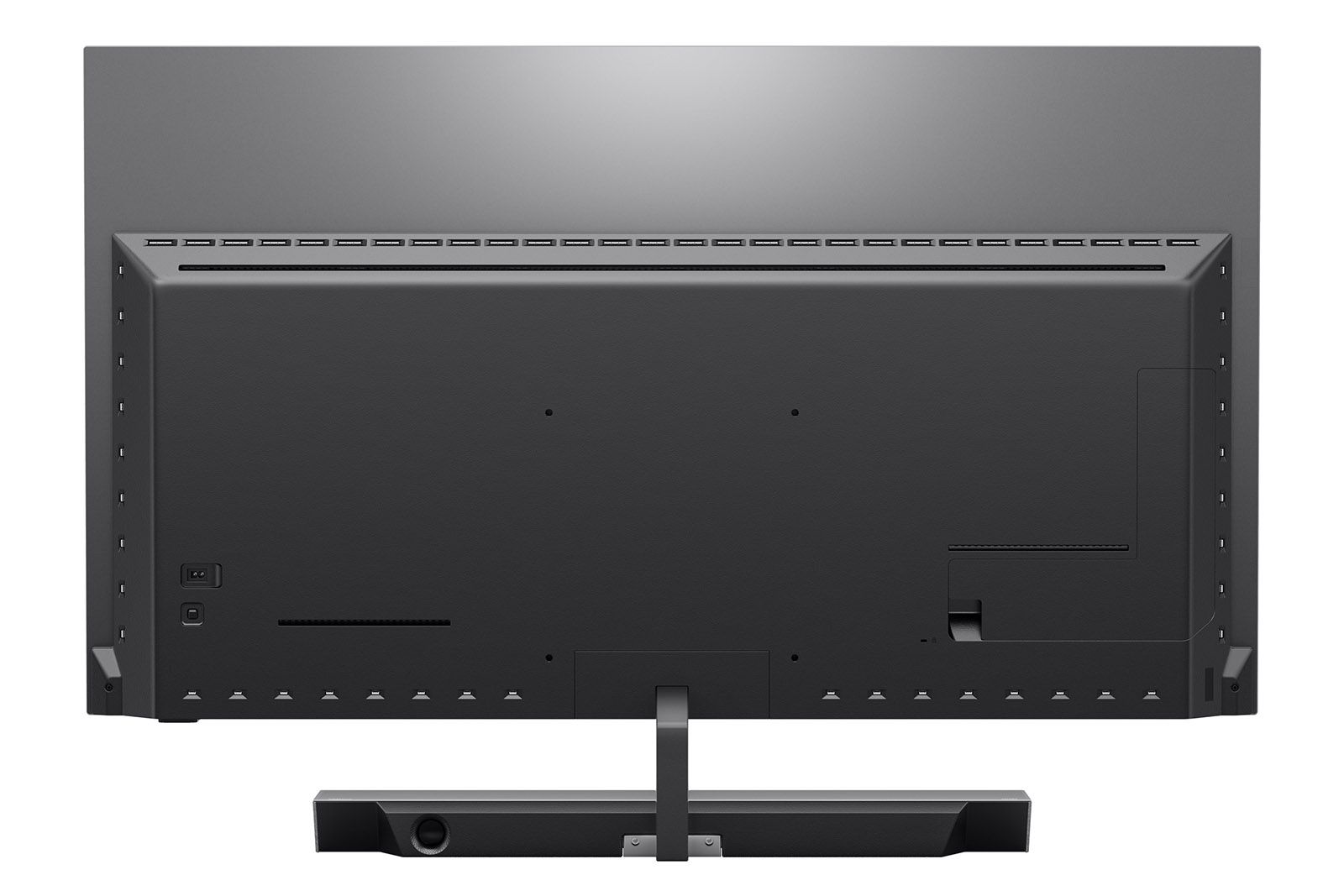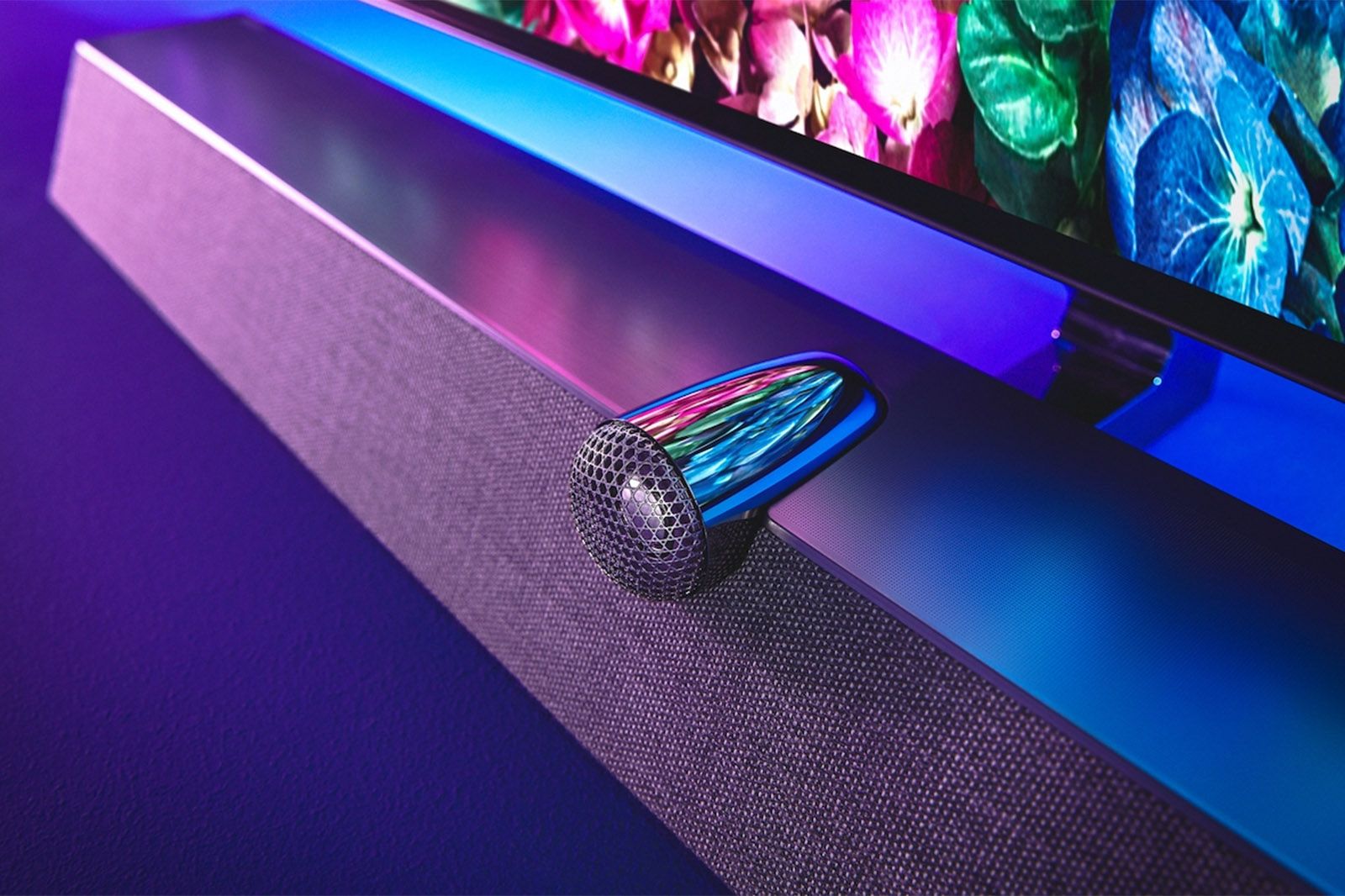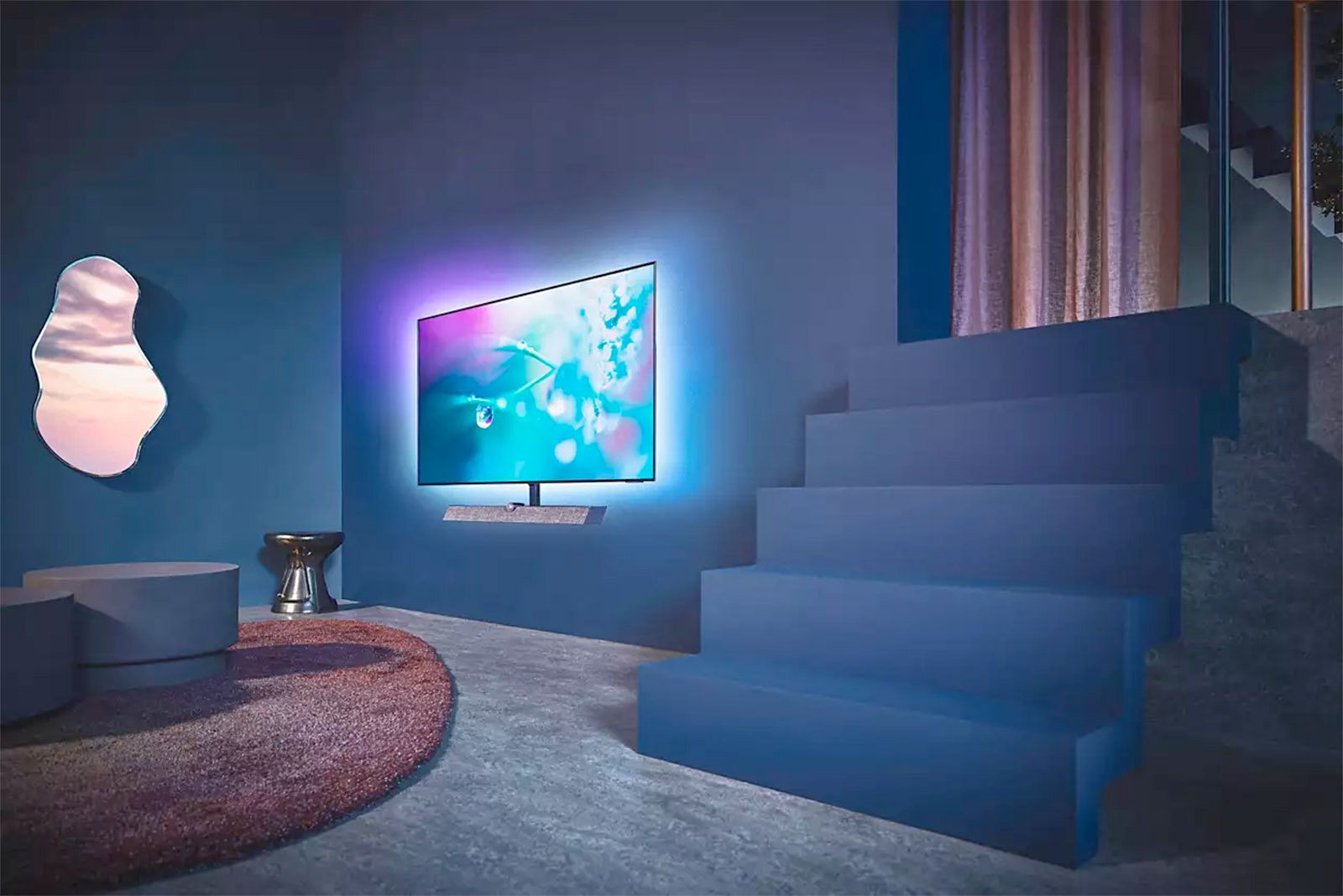The Philips 65OLED+935 leaves pretty much no stone unturned in its quest to live up to its status as Philips' flagship TV for 2020.
Its beautifully designed and built, it features Philips' most advanced picture quality engine ever, and it even sports a sensational audio system designed by bona fide hi-fi superstars, Bowers & Wilkins.
In fact, provided you don't let yourself be intimidated by it, it's arguably the most all-round spectacular OLED TV to date.
Our quick take
If you're a die-hard gamer, the OLED+935's lack of support for next-gen gaming features and slightly high input lag may count against it.
For everyone else, though, its combination of supremely good AI-inspired picture quality, almost unbelievable B&W-designed sound quality, and effortlessly gorgeous Ambilight-bolstered design is nigh-on irresistible.
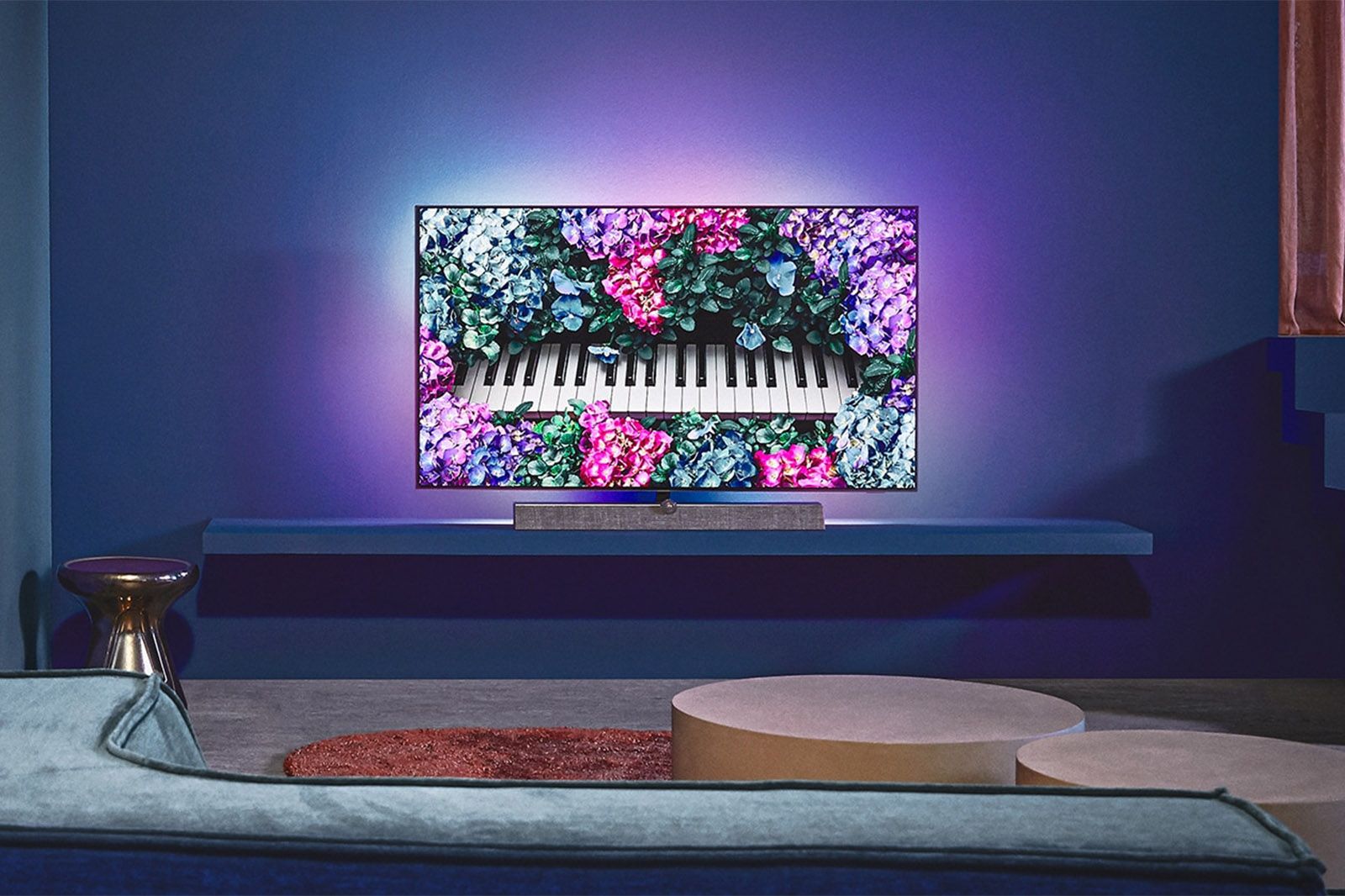
Philips OLED+935 - 5.0 / 5
| FOR | AGAINST |
|---|---|
|
|
65 PHILIPS Ambilight 65OLED935 12 Smart 4K Ultra HD HDR OLED TV with Google Assistant
Design
- 4x HDMI inputs, 2x USB ports
- LAN & Wi-Fi multimedia
Everything about the OLED+935's design looks and feels premium. The brushed aluminium finish that provides the backing of the OLED panel, for instance, is exquisite. The frame around the screen is narrow enough to provide barely any distraction from the set's explosive pictures, and the screen is also just a handful of millimetres deep at its edges.
Most spectacularly of all, the entire screen is surrounded by coloured light courtesy of a four-sided version of Philips Ambilight technology. This uses LEDs mounted on the chunkier part of the rear panel to pump out light that can marry up with the colour content of the images playing on the screen.
The accuracy with which Ambilight can place and match colour tones really is pretty remarkable, so provided it's run at a fairly gentle brightness level, it can enhance the viewing experience almost spookily well.
Just as eye-catching as the OLED+935's Ambilight system is the external speaker enclosure that doubles-up as the TV's desktop support if you're not wall-mounting it.
This speaker enclosure is big enough to both support the TV stably and give the speakers inside room to work with, while also looking seriously handsome thanks to the grey Kvadrat fabric finish of its front edge and the appearance along its top edge of one of B&W's distinctive 'tweeter on top' features.
This isn't just there to look cute, of course; separating treble from the rest of the sound keeps it free of colouration from the medium and bass drivers.
The speaker enclosure also has a few less obvious tricks tucked away inside, including a large dedicated bass driver and a pair of upfiring speakers on its top edge in support of the set's built-in Dolby Atmos decoding.
The only less-than-stellar thing about the OLED+935's design is its inputs. These are numerous enough with four HDMIs, two USBs, and Wi-Fi/Bluetooth support. The HDMI ports, however, don't support 4K at 120Hz or variable refresh rate (VRR) features which have just become a big deal with the arrival of the Xbox Series X and PlayStation 5 (not to mention the newest generation of high-end PC graphics cards).
Picture Features
- HDR Support: HDR10, HDR10+, Dolby Vision, HLG
- Processing engine: 4th-generation P5 engine
Philips has embraced artificial intelligence (AI) technology for the first time with its 2020 OLED TVs. AI is a process that begins in Philips' labs by building up a vast database of picture quality know-how by feeding millions of different images through a neural network.
In Philips' case, the results of this process have been used to allow the OLED+935 to divide individual objects in incoming pictures into five categories: Nature, Face, Motion, Dark and Other.
Objects filtered into the first four of these categories receive new optimised processing designed to deliver more natural looking results. Picture objects filtered into Other receive more or less the same processing treatment that was applied to images by Philips' 2019 TVs.
Philips' cheaper OLED805 range of TVs also benefits from the new AI workings. The OLED+935s, though, take it further. For starters, they carry an extra AI-dedicated chip to improve the speed and accuracy of the AI application.
There's an extra colour management feature, too, called AI Smart Bit Enhancement 2.0. This claims to be capable of uplifting 8-bit video to near 14-bit levels of precision, removing the banding that can appear in subtle colour blends without sacrificing sharpness and detail.
Also exclusive to the OLED+935 is AI Machine Learning Sharpness. This assesses the best sharpness level to apply to different elements of any given frame, rather than just applying a single monolithic sharpness algorithm across the whole screen. A process that should result in a more three-dimensional and less noisy final picture.
Philips' Perfect Natural Motion (PNM) system for converting standard dynamic range sources into HDR also gets a boost from the OLED+935's AI-inspired processing. In fact, Philips can even put a number on the level of enhancement, stating that thanks to PNM's new picture highlight detection and enhancement technology's perceived sharpness is as much as 30 per cent higher than it was previously.
One final key picture feature exclusive to Philips' OLED+935 models may be for some people its most significant: anti burn-in technology. Since OLED panels use organic materials they're susceptible to burn in - shadowy ghosts of bright static image elements that can start to be permanently etched onto the screen over time. The OLED+935 claims to reduce the potential of screen burn by using its processing horsepower to divide the image into 32,400 separate zones, looking for parts of the image that aren't moving, and gently dimming such parts down.
The OLED+935's new and exclusive AI picture features are joined by the 'five pillars of picture quality' video processing principles deployed on Philips' previous few TV generations. These start with the assumption that good picture quality can be boiled down to five key elements: source detection, motion handling, sharpness, colour and contrast. Philips then applies a number of different processing elements to each pillar, in the order likely to deliver the best final results.
As usual with Philips TVs, the vast majority of its picture processing features can be turned off or have their strength adjusted. Though it's worth noting that the addition of AI means that such manual tweaking is both less necessary and actually more risky than it has been on previous Philips TVs. This is chiefly because the AI is already delivering a more balanced, nuanced picture, so any manual adjustment can potentially throw the AI balance off.
One last big picture attraction of the OLED+935 is its ability to play all the big HDR formats. So as well as the now-standard HDR10 and HLG formats, it can also handle Dolby Vision and HDR10+. These two premium HDR formats add extra scene-by-scene data to the video stream to help compatible TVs deliver more consistently accurate and dynamic HDR pictures. Most rival brands, though, only support HDR10+ or Dolby Vision, not both.
Smart Features
- Smart System: Android TV
- Freeview Play
Android TV's epic journey from smart TV horror show to actually pretty handy smart TV interface advances another helpful mile with the OLED+935.
Navigating the menus now feels as smooth as butter compared with the laggy, stuttery experience of Android in days gone by. It's also much less prone to crashes and glitches than it used to be - helped out by the hefty processing overhead that the OLED+935's gigantic brain can put at its disposal.
Efforts have also been made with the latest Android TV 9.0 (Pie) version to put more emphasis on the video streaming services that are the bread and butter of any smart TV experience. There are still a rather intimidating 5000+ apps to be found on Android TV if anyone cares to seek them out, but fortunately these now feel like an adventure that users can choose to have rather than a frustrating distraction from the really important stuff.
The Android home page still takes over the whole screen, which feels a bit clunky versus most rival smart TV systems. Its use of large icons limits the number of direct content links it can provide on screen at once, too, and it's still not as brainy as some rivals at learning what users like to watch and making targeted recommendations accordingly.
It is easy to read, though, and there are now more tools available for customising its layout. Google Assistant is on board to deliver handy voice control shortcuts, too, and as with all Android TVs the OLED+935 supports direct Chromecasting from compatible smart devices.
The huge amount of apps Android TV carries now includes almost all of the big hitters: Netflix, Amazon Prime Video, YouTube, Rakuten, and so on. Philips has also finally got around to adding Freeview Play to its smart options, too, so all the main UK terrestrial broadcaster catch-up apps are present and correct. The only really key ongoing absentee is Apple TV.
Picture Quality
The addition of AI to Philips' heavy duty picture processing is transformative, keeping the trademark Philips aggression but adding a stunning new level of refinement and balance that brilliantly counters the old Philips tendency to sometimes push things a little too far.
This new 'checks and balances' effect of the AI system is at its most noticeable with the OLED+935's colour handling. Tones still look extremely vibrant and rich - at least when using the Philips-recommended Natural or, especially, Vivid picture presets - but now tones seldom stray into gaudy territory, or feel out of kilter with their neighbours. The result is a more organic and balanced portrayal of colour across all sorts of different source types.
It's a similar story with the OLED+935's sharpness and detail. So while the picture maybe doesn't look quite as sharp overall as that of Philips' 2019 OLED sets, the sharpness varies more in different parts of the image. Exactly as it would in the real-world based on different lighting levels and object distances. So the results look more natural, more three dimensional, and with much less likelihood of any part of the image looking unnaturally over-sharp or gritty.
Contrast, meanwhile, is just glorious. Philips has been uniquely good at eking out slightly more dynamism from high dynamic range (HDR) OLED pictures for a couple of generations now. The OLED+935, though, ups the ante again by somehow injecting even more local intensity into the brightest highlights of HDR images - reflections of sun on metal, stars in the night sky, street lamps, and so on.
What's more, since this has been achieved without sacrificing OLED's phenomenal black level capabilities, contrast-rich HDR shots and sequences routinely feel more intense and dynamic than they do on premium LCD TVs, despite those LCD TVs boasting much higher peak brightness levels.
In fact, the OLED+935 can briefly deliver an impressive (by OLED standards) 900 nits brightness. But the cleverness of the AI-driven processing frequently makes it feel like it's hitting much higher brightness levels than that, at least in small areas of the screen.
There can be a touch of detail loss in the very darkest picture areas, but this happens so rarely and is so subtle that it shouldn't be considered a big deal. The set's handling of near-black image content is typically exceptional, keeping noise to a minimum and avoiding the sudden black level 'jumps' that some rival OLED TVs can exhibit during very dark scenes.
Bright HDR scenes hold on to more full-screen intensity than they typically do on OLED TVs, too - more so, even, than they do on 2019's Philips TVs, or the step-down Philips OLED805 series for 2020.
It's great to enjoy this sort of intensity from an OLED screen, too, in the knowledge that Philips' new anti burn-in measures are hopefully doing their bit to limit the chance of the screen's intensity reducing its working lifespan. Though it isn't possible, of course, to actually test this aspect of the OLED+935's performance without holding on to the TV for months or even years.
With contrast - as with almost everything else about the OLED+935's pictures - the new AI polish ensures that even the most high contrast shots don't look forced. And since the potential to occasionally make pictures look a bit artificial has long been the only fly in Philips TVs' picture quality ointment, the impact of this new consistency and naturalism can't be overstated.
Even motion - long the subject of Philips' most controversially aggressive processing efforts - enjoys a new lease of life on the OLED+935. The new processor reduces the digital side effects associated with Philips' traditional motion processing options, for starters. But what's really exciting is the addition of a new Pure Cinema option that does a borderline miraculous job of massaging down excess judder without either generating distracting side effects or over-smoothing the picture to the point where movies look like soap operas.
Fans of picture standard accuracy concerned about the OLED+935's still aggressive approach to pictures, even with AI involved, should note that the set's Movie mode turns off the vast majority of the picture processing tools. In fact, it's the independent UHD-Alliance's Filmmaker Mode in all but name, meaning that it's designed to deliver an experience closely aligned with the look and feel the content creators were working with when they mastered their content.
It seems arguably a bit odd to spend so much on a processing-rich flagship TV and then turn all that processing off. But it's always welcome when TVs offer so much choice over how their pictures look.
Similarly, the OLED+935 can both look gorgeous with standard dynamic range (SDR) content values, but also appear remarkably assured and enjoyable with its SDR-to-HDR conversion in play. Especially as the AI processing is now on hand to tone down the HDR conversion's potential colour excesses and apply a more organic, object-based approach to the set's upscaling of HD sources.
Inevitably, even adding AI hasn't taken out all of the OLED+935's picture niggles. As noted earlier, shadow detailing occasionally gets lost in the quest for perfect black levels. The Vivid mode can still push too far with some colours and peak light areas. The noise reduction processing elements can still come on a bit strong, too, even with AI in play (they wreak the most havoc in the dedicated HDR AI preset). As a result, they're probably best turned off or kept to their lowest power settings when watching any decent quality source.
The 36.5ms of input lag measured in the TV's Game mode is relatively high by today's TV standards. And finally, while regularly tweaking picture settings is much less necessary now than it used to be thanks to AI, very sensitive users will sometimes want to refine things a bit. At which point both the complexity of the TV's menus and the care that must be taken not to throw the AI off balance can create a few challenges.
Sound Quality
The B&W-designed speaker enclosure looks serious and sounds better. With Dolby Atmos movies, for instance, the scope, scale and dynamism of the sound stage it produces is ridiculous for a built-in TV audio system. Indeed, there are plenty of pretty high-end soundbars out there that can't hold a candle to it.
The front drivers propel left, right and centre channel information into the room with exceptional directness and impact, yet without sounding in the slightest bit harsh or soupy, even at volume levels far beyond anything most TVs - or soundbars - could dream of attempting.
The sound swells massively from the instant it leaves the drive units too, ensuring that the sound isn't distractingly locked to the speaker enclosure and, more importantly still, that voices don't sound as if they're coming from below the screen.
The sound doesn't just drive forwards, though. It also spreads far beyond the confines of the screen, left, right and upwards.
Other TVs have built up-firing drivers in to their integrated sound systems. None, though, have got close to sounding as convincing in presenting the distinctive Dolby Atmos sense of height as the OLED+935 does. Both in terms of how height effects really do reach to the ceiling, and how convincingly layers of height effects are placed into this soundwall.
Again there's no hint of sharpness or topping out to even the most far-flung location effect in an Atmos mix, and the massive mid-range dynamics and treble purity is underpinned by levels of bass that are hard to reconcile with the fact that the TV doesn't deploy an external subwoofer.
Naturally there is a limit to what the OLED935 can do with Atmos, in that while you get a sense of sound effects to the side of you, there isn't much going on behind you. Similarly, when objects move overhead you don't really get a sense of any front to back or back to front transition. But this is only to be expected with no rear speakers in play.
The OLED+935's audio talents are, if anything, even more extraordinary with music. The power, scale and dynamics are still there, but you also become aware of just how much subtle detailing and musicality the sound has, in terms of both its timing and the cohesive but expressive way it presents both the most delicate and most aggressive elements of every mix.
It's hard to imagine how any TV brand could have combined the sort of power the OLED+935 ships with a truly hi-fi sensibility without the (clearly extensive) input of a speaker brand as acclaimed as B&W.
65 PHILIPS Ambilight 65OLED935 12 Smart 4K Ultra HD HDR OLED TV with Google Assistant
To recap
If you're a die-hard gamer, this telly's lack of support for next-gen gaming features and slightly high input lag may count against it. For everyone else, though, its combination of supremely good AI-inspired picture quality, almost unbelievable B&W-designed sound quality, and effortlessly gorgeous Ambilight-bolstered design is nigh-on irresistible.

